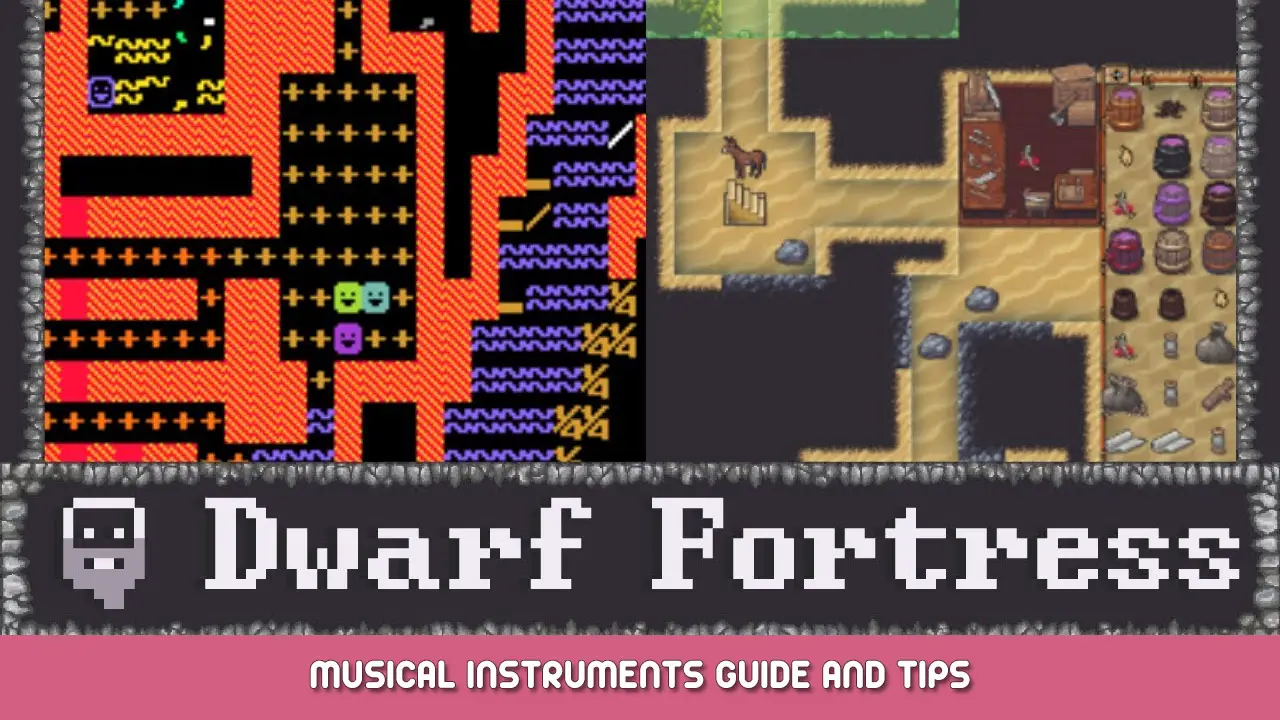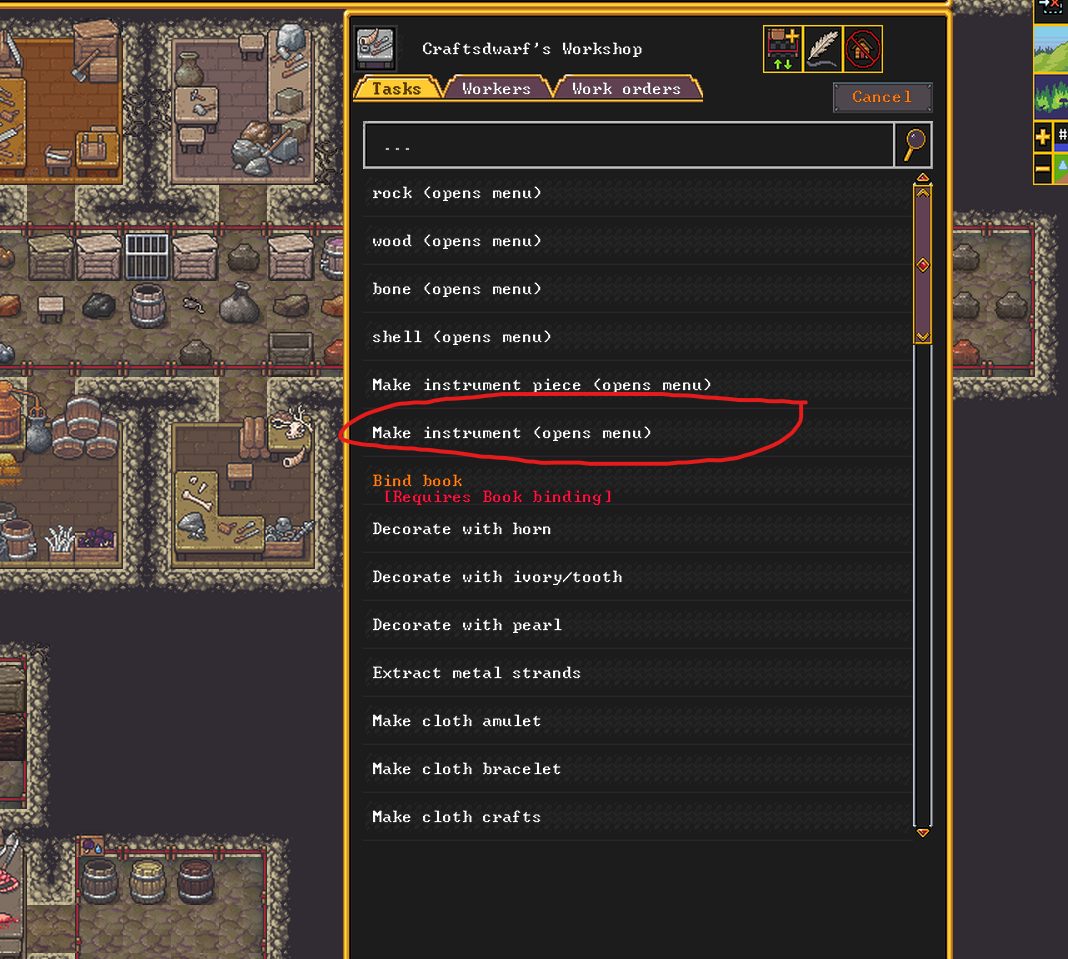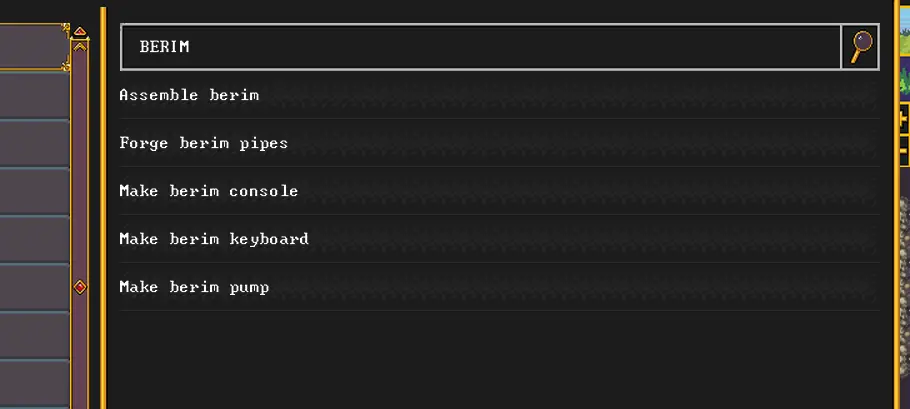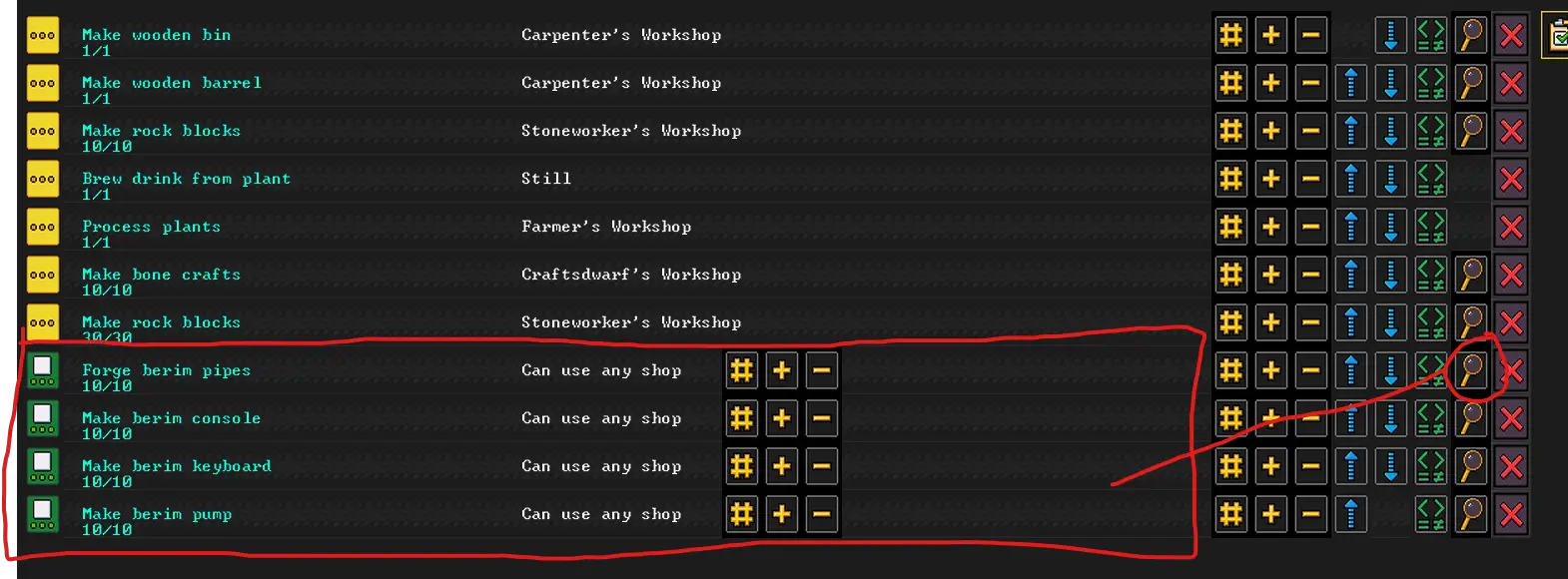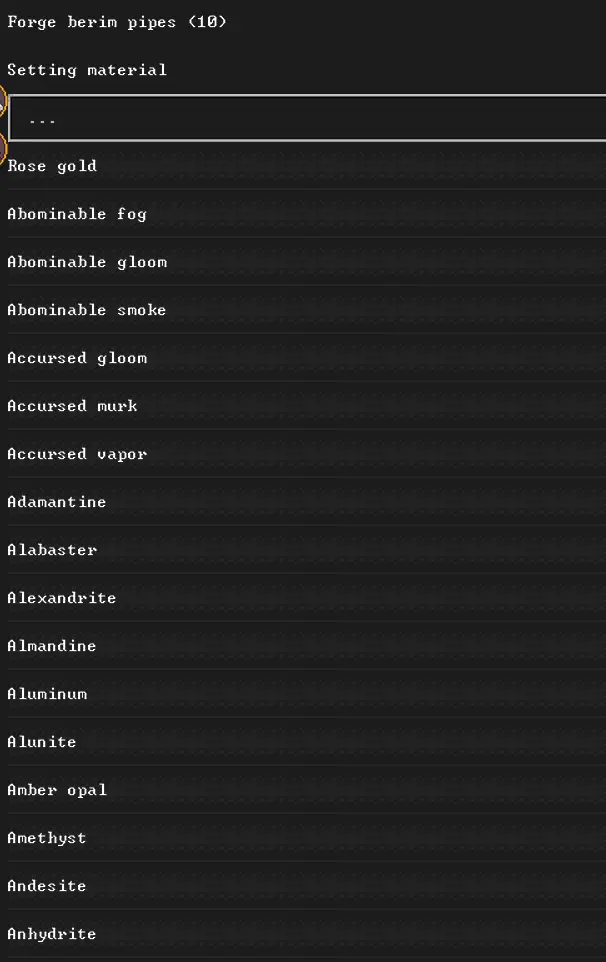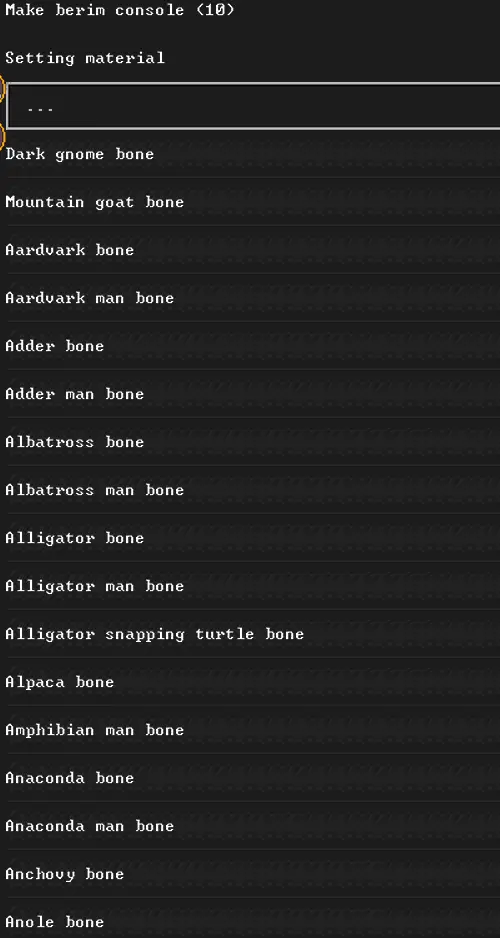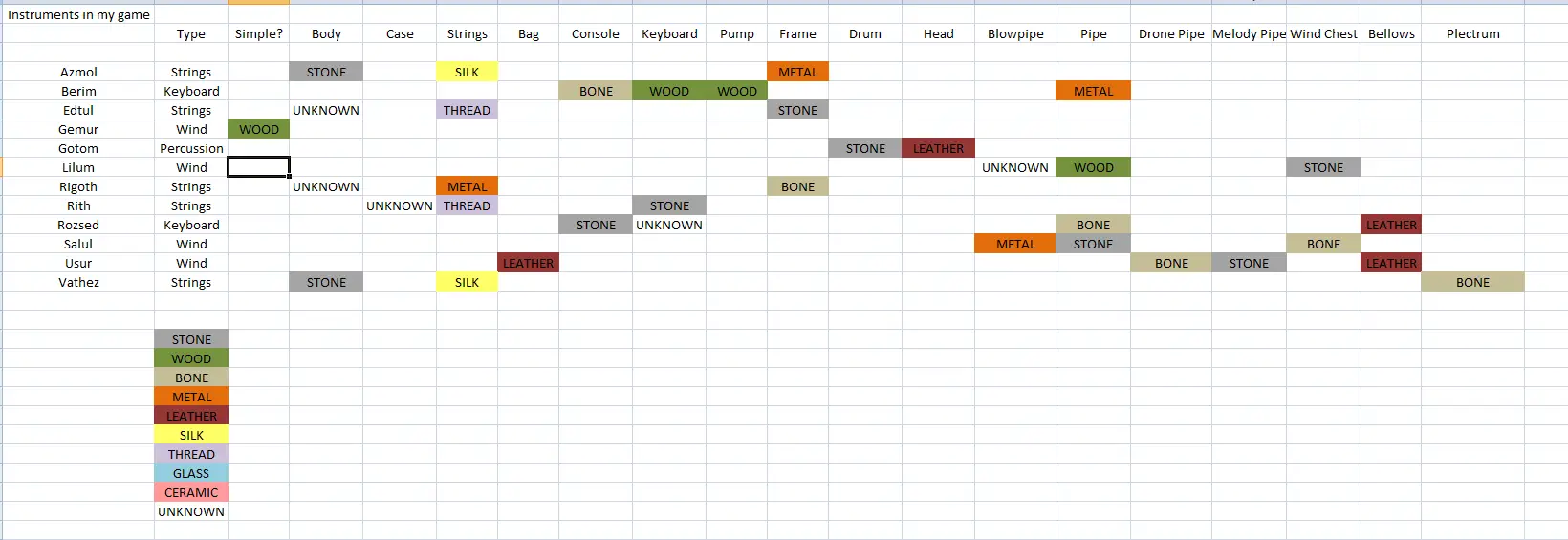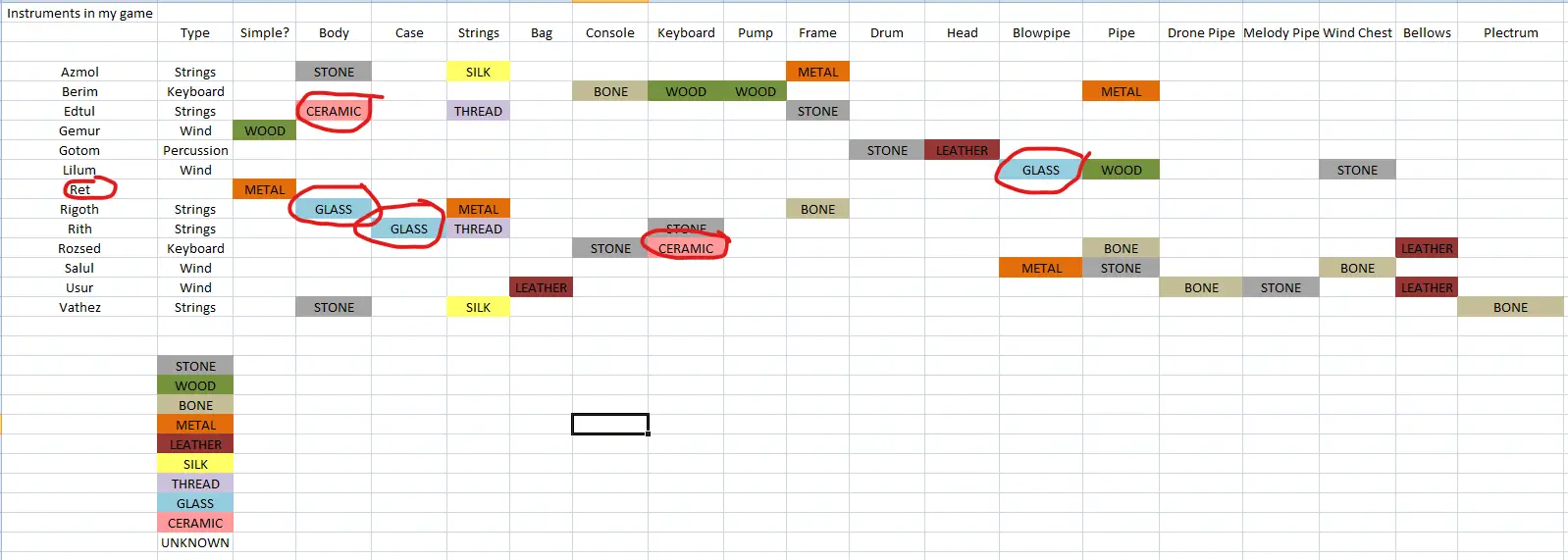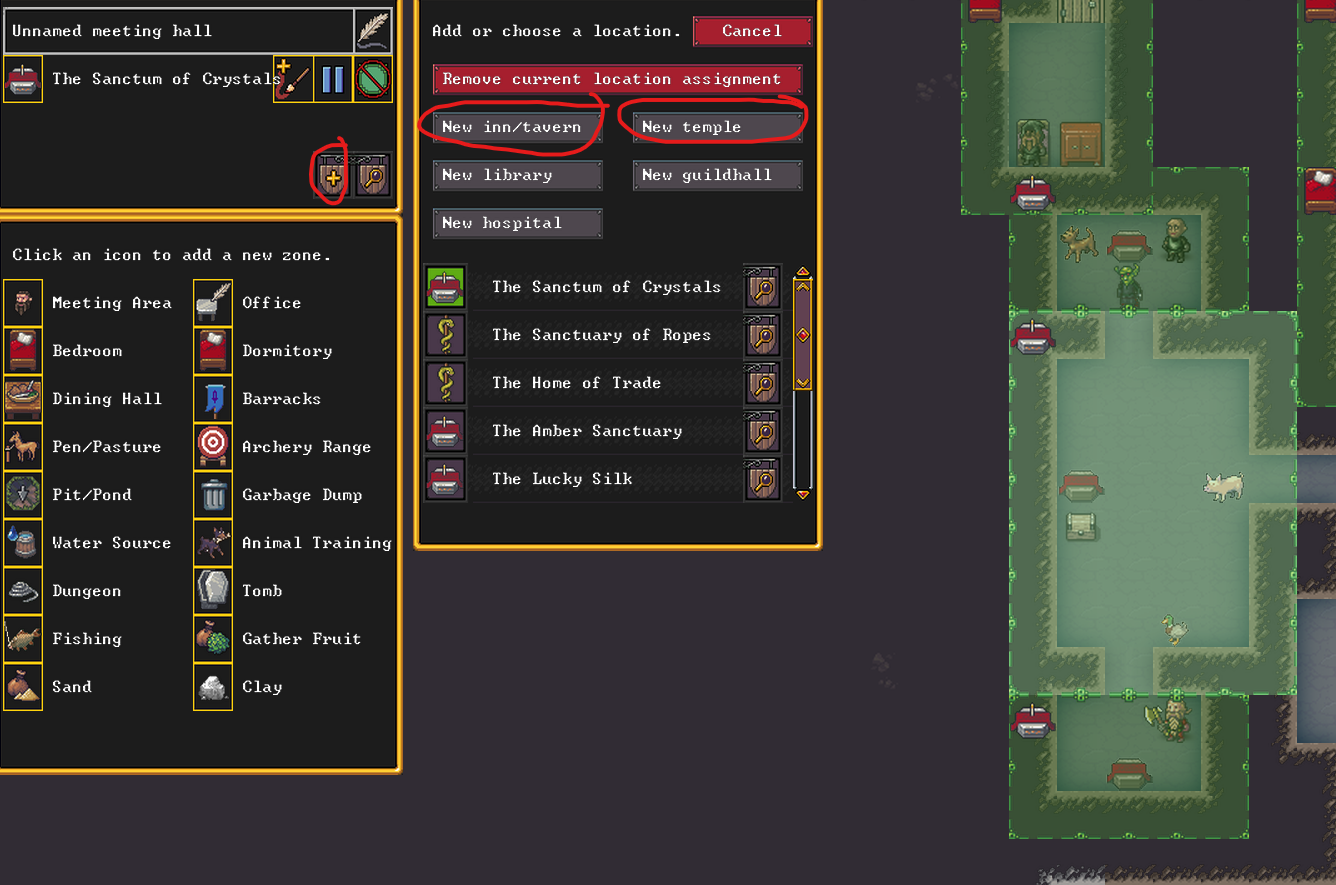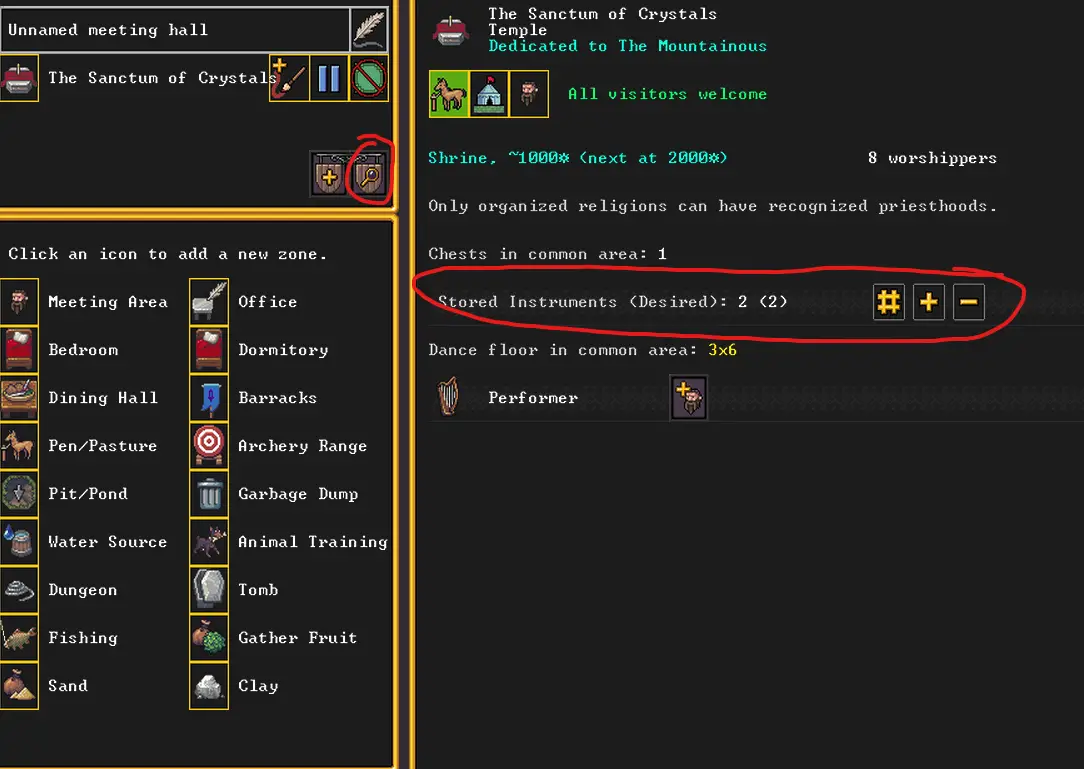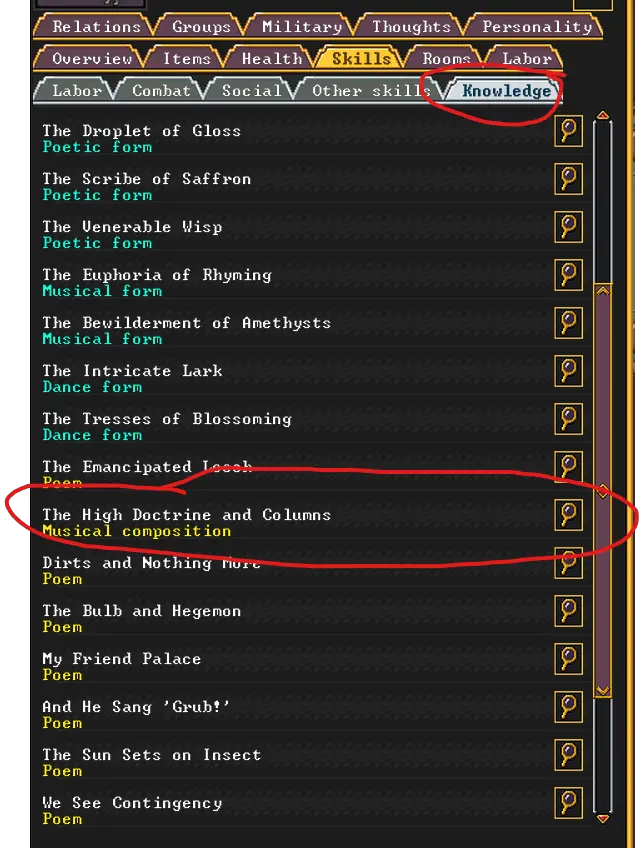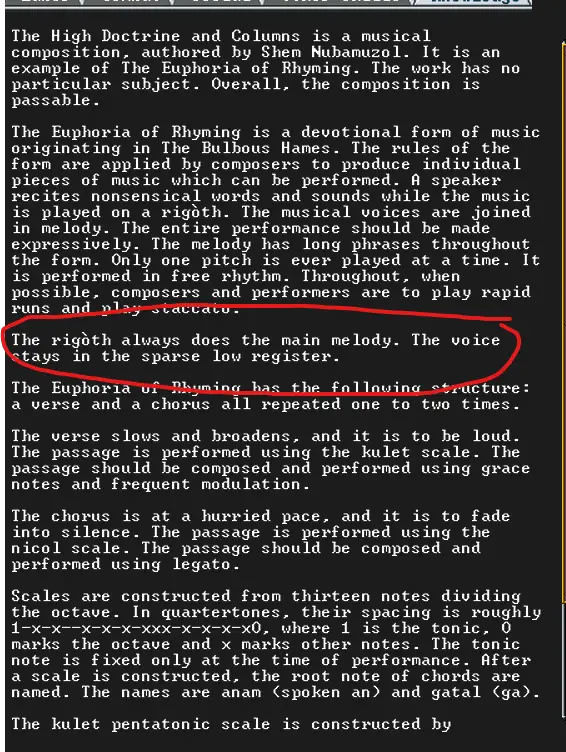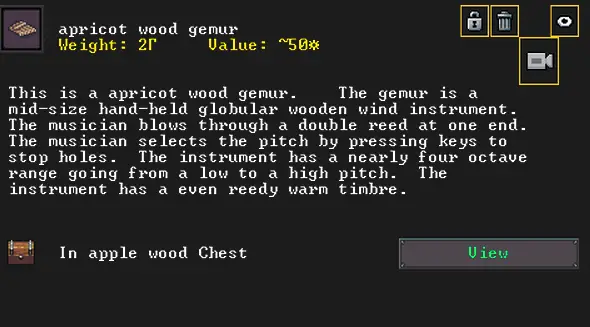I found this part of the game a bit frustrating to figure out, so this is a short guide to help you figure out what your musical instruments are in your fortress and how to construct them.
Einführung: The Dwarf Fortress Wiki
I find Dwarf Fortress impossible to play without keeping the Dwarf Fortress Wiki open at all times.
It is very helpful when finding out the basic mechanics of certain gameplay concepts, or simply if you aren’t sure what a particular word or skill does, or means.
When viewing the Dwarf Fortress Wiki, im Hinterkopf behalten:
- All of the hotkeys listed in articles will be for the non-Steam version of the game, and so you probably shouldn’t try to follow the exact hotkeys an article will sometimes lay out.
- Anything under the heading „D for DWARF“ is a meme and can be ignored if you’re just trying to figure out how things work.
- It isn’t a great resource if something in your game isn’t working as you (or the article you’re reading) would expect.
Musical Instrument Basics
The link to the Dwarf Fortress Wiki article on Musical Instruments can be found Hier.
if you would prefer to simply read that. I will try not to repeat the article but I do have some helpful tips to add that will assist you in sorting out your musical instrument situation in your own game.
Here are some quick things to know about musical instruments in Dwarf Fortress.
Erstens:
You will not find the ability to make a guitar, or piano, or even a drum, in Dwarf Fortress. During the world generation step, each CIVILIZATION (Zwerg, Menschlich, Elf, and probably Goblin and Kobold as well) will likely have its own musical instruments, with procedurally generated names, such as a „Lilum“ oder ein „Usur“.
Bedauerlicherweise, until there is a Legends Mode viewer mod or other program available for the Steam Version of Dwarf Fortress, there is really no easy way to look up this information. Jedoch, you can find it out during Fortress mode with a little effort. Please see „What Instruments Do I Have?“ later in the guide.
Zweitens:
The construction and materials required for each of your musical instruments is also procedurally generated.
As per the Dwarf Fortress Wiki, there are four generic types of Instruments: Tastaturen, Stringed, Wind and Percussion, and they might be handheld or stationary (dh. built like a furniture piece).
Musical instruments can require many different pieces (all procedurally chosen), and they can also be so simple that they require only one piece.
Each component can be made out of a particular type of material. Some materials are restricted (Zum Beispiel, Die „Strings“ component of a Stringed Instrument can only ever be Silk, Plant Thread, or Metal), but if you are unlucky, all your instruments might be difficult or complicated to make. Glücklicherweise, as far as I can see, no instrument requires a specific subtype of component (Zum Beispiel, a stone component will require any stone, not granite only, or bauxite only, usw).
Endlich:
Musical Instruments are not required for your Fortress to work. Dwarfs use them to play in Temples and Taverns in order to make themselves happy, but they do not require them to either Worship or Socialize. You can also trade them if you like. I suppose they might be required under some noble mandates, but that’s it.
This guide is just to save you some frustration if you want to make them.
What Instruments Do I Have?
In order to find out what die meisten davon musical instruments are for your Civilization during Fortress mode, you can make a Craftdwarf’s Workshop. Any instrument with multiple components will be assembled here.
Select your Workshop and go to Make Instrument .
Wie Sie sehen können, Ich habe 12 Musical Instruments listed here, from an „Azmol“ zu einem „Vathez“. Most of these cannot be built currently in my fortress, but I am lucky enough to have a single-piece (aus Holz) instrument called a „Gemur“. Perhaps you will be so lucky in your own game.
Single-piece instruments are also the reason why the Craftdwarf’s Workshop isn’t comprehensive about which instruments are available. The single-piece instrument might not be made of a material that the Craftdwarf’s Workshop can process.
In any event, I recommend you write down the names of any assembled instruments here, in order to do the next step, or even better, make a spreadsheet!
How Do I Make An Assembled Instrument?
Assembled instruments can require a variety of components, some of which require specialized workshops.
This is the full list of all workshops that a component (or single-piece instrument) might be made in:
- Carpenter’s Workshop;
- Glass Furnace;
- Ofen;
- Leather Works;
- Stoneworker’s Workshop;
- Metalsmith’s Forge
Zusätzlich, certain materials required may need further specialized workshops (such as the Farmer’s Workshop, used to make Plant Thread or Silk) which will then be fashioned into the component at the Craftdwarf’s Workshop.
The full list of materials that may or may not be used for components is:
- Seide
- Plant Thread
- Leder
- Holz
- Knochen
- Keramik
- Metall
- Glas
- Stein
- Hülse
Certain components are only possibly made of certain materials; Strings can only be Silk, Plant Thread or Metal, Zum Beispiel, but as it is impossible to tell what your components might be ahead of time, you may want to be prepared for any options.
As far as I can see, the easiest way to find all the components is to use Work Orders. Erstens, you need to appoint a dwarf to be your Manager, falls Sie es noch nicht getan haben, via the Nobles and Administrators screen.
Once you have a Manager, go to the new Work Orders page and Make a New Work Order.
Once you’re in the Work Orders Screen, type in the name of the instrument you want to try to make. I have typed in „Berim“ here as an example:
Wie Sie sehen können, A „Berim“ appears to have four parts: Rohre, Konsole, Keyboard and Pump. It is also a Keyboard instrument (although it does have Pipes as well; perhaps it is a Pipe Organ). The type of instrument is really only for flavour anyways; there is currently no way to tell what exactly the instrument will be (in Fortress Mode) until you build it.
Now to find out what type of materials you need, you must add Work Orders for each instrument part, einer nach dem anderen. Bedauerlicherweise, you need to go type in the instrument name each time. We won’t be filling the Work Orders anyways, so don’t worry about losing any valuable material.
Here is my Work Orders screen afterwards:
Endlich, you click on the magnifying glass for each part, Welches ist „Set Material“. This will give you the list of all available materials for this component.
Zum Beispiel, the list for the „Berim Pipes“ sieht so aus:
Whereas the list for the „Berim Console“ sieht so aus:
So the „Berim Pipes“ are made from Metal, und die „Berim Console“ is made from Bone. It turned out the other two components were made of Wood.
An interesting note is that I didn’t even need to look at the „Berim Pipes“ materials list. A keen-eyed player will see that it says “
SchmiedeBerim Pipes“, which always denotes a Metal component. As far as I can see, this is the only material with a different keyword.
Bedauerlicherweise, you have to do this process for every component of every instrument in your civilization.
I strongly recommend you note the components and materials in a spreadsheet, so you never have to do it again for this particular civilization.Auch, don’t forget to cancel your Work Orders afterwards!
End Results
I made a spreadsheet for all the instruments in the original list I showed you, so you can see what it might look like.
Wie es sich herausstellt, Ich habe 5 Stringed, 2 Tastaturen, 4 Winds and 1 Percussion instrument in my civilization. If you’d like to tell ahead of time, the Dwarf fortress article on Instruments has some tables that can let you know, based on the names of certain components, what the instrument will be.
For the record, my one ‚einfach‘ Instrument, Die „Gemur“, is a Wind Instrument, but I only know that because I made a few. As far as I can see, there was no way to tell ahead of time.
Here is an example of the „Rigoth“ Work Order list, which is one of my unknown options.
Wie Sie sehen können, Die „Rigoth Strings“ are made out of Metal, thanks to the Forge keyword, and it turns out the „Rigoth Frame“ is made of Bone, aber die „Rigoth Body“ does not have a materials list at all.
This is because Glass and Ceramic object do not currently have the ability to choose from material lists (even though they do have different materials, the option is not yet enabled in the game). daher, the magnifying glass is missing from the Work Orders screen, Aber, due to this meta-knowledge, Die „Rigoth Body“, and all other items of this type, must be made of either Glass or Ceramic.
Checking the Glassworks and Kiln, I was able to determine that the „Rigoth Body“ was made of Glass, as were two other components, whereas two further components were made of Ceramic.
I also discovered a thirteenth instrument, called a „Ret“, which was a simple instrument made exclusively from Metal, and so was only visible from the Metalworks.
What Do I Do With Them?
Momentan, Musical Instruments can be assigned to two locations: Temples and Taverns.
These are both Meeting Places, so you first zone an area as a Meeting Place, then designate it as an Inn/Tavern or as a Temple. For Temples, make sure you pick a relevant Deity or Pantheon for your Dwarves, which can be a chore on its own to figure out.
Once you have designated a Temple or Tavern, you need to place a Chest in which to store the Instruments in question, assuming they are handheld-sized instruments. You can change how many instruments are assigned to each chest by using the Zone Details Options.
If they are Furniture-sized instruments, I believe simply placing them in the Zone in question will work.
If you have any dwarfs that you would like to Perform, you will likely have to assign them as Performers to the Tavern or Temple in question.
Endlich, you may need to take a deep dive into your Dwarfs‘ Knowledge category and find out if they know any Musical compositions:
und wenn ja, which the musical composition requires:
Looks like I may have to make a „Rigoth“ schließlich.
Auch so, I have not thoroughly tested this part of the game. Please let me know if you have any notable success, or failure, involving dwarfs using instruments.
Apparently musical instruments have very high base value ratings, so with a good crafter, you can sell them for quite a bit of money. Make sure to look at the tables on the Dwarf Fortress wiki to see what part of the instrument counts for quality purposes, as only the ‚hauptsächlich‘ parts add value to the item.
Abschluss
Here is a finished „Gemur“, which turns out to be some sort of wood carved ‚“recorder“ oder „pan flute“ type wind instrument. I can update the guide with more instruments from this save when I make them, if I survive…
I hope this guide helped you in some small way. Please feel free to comment with advice or your own instrument information.
Das ist alles, was wir heute dafür teilen Zwergenfestung Führung. Dieser Leitfaden wurde ursprünglich erstellt und geschrieben von Cragspyder. Für den Fall, dass wir diesen Leitfaden nicht aktualisieren können, Sie können das neueste Update finden, indem Sie diesem folgen Verknüpfung.
